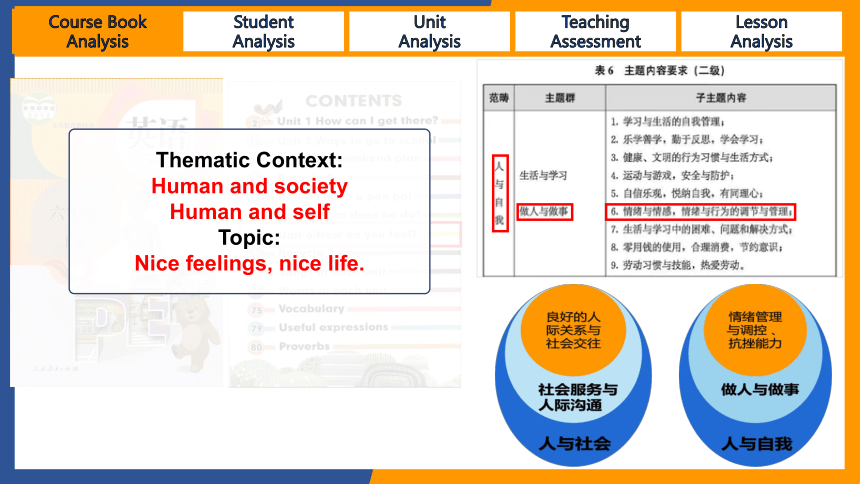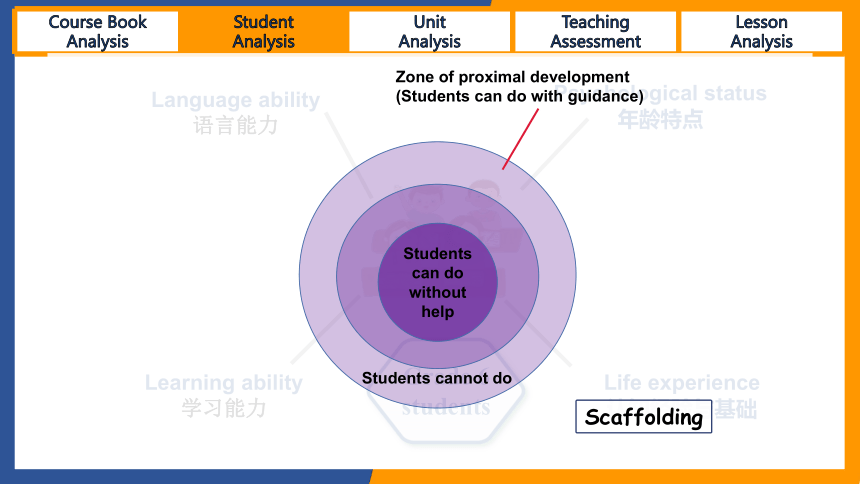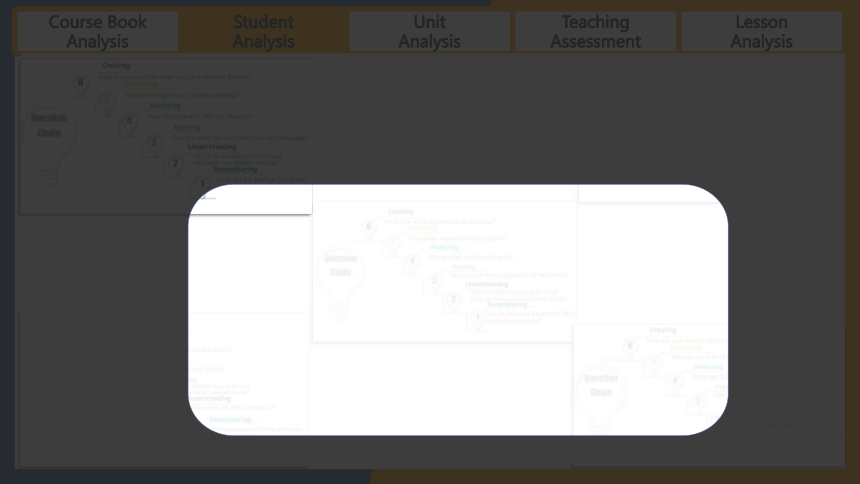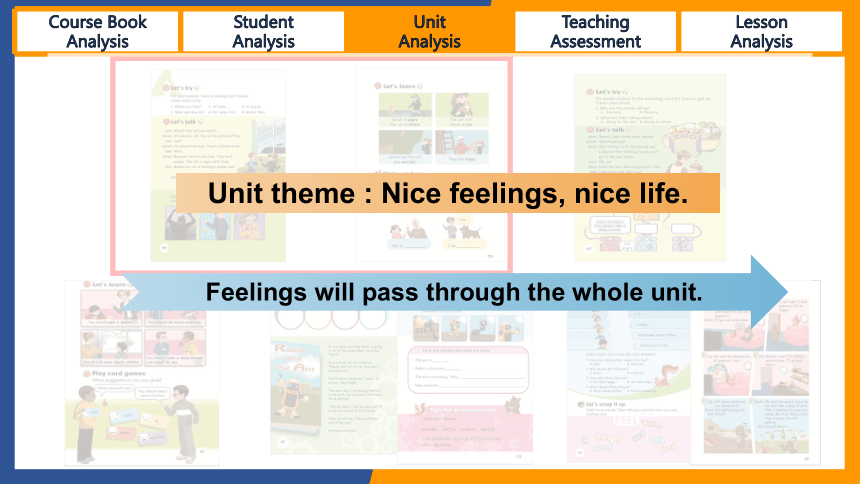Unit 6 How do you feel? A Let's talk & A let's learn说课课件(共35张PPT)
文档属性
| 名称 | Unit 6 How do you feel? A Let's talk & A let's learn说课课件(共35张PPT) |

|
|
| 格式 | pptx | ||
| 文件大小 | 76.5MB | ||
| 资源类型 | 试卷 | ||
| 版本资源 | 人教版(PEP) | ||
| 科目 | 英语 | ||
| 更新时间 | 2024-04-28 21:53:06 | ||
图片预览












文档简介
(共35张PPT)
Unit 6 How do you feel?
单元整体说课
PEP版六年级上册
单
元
整
体
说
课
PEP Primary English Book 7
Unit 6 How do you feel?
Nice feelings, nice life.
Theoretical Basis
English Subject Core Competencies
英语课程核心素养
Unit Integral English Teaching Approach
单元整体设计
English Learning Activity Approach
英语学习活动观
Integration of Teaching, Learning and Evaluation
教-学-评一体化
Bloom's Taxonomy of Learning
布鲁姆学习法
Bloom’s Taxonomy
CONTENTS
目录
01
02
03
04
05
06
Student Analysis
Course Book Analysis
Unit Analysis
Teaching assessment
Lesson Analysis
Thematic Context:
Human and society
Human and self
Topic:
Nice feelings, nice life.
Course Book Analysis Student Analysis Unit Analysis Teaching Assessment Lesson
Analysis
Psychological status
年龄特点
Language ability
语言能力
Life experience
认知经验与基础
Learning ability
学习能力
Grade 6 students
Course Book Analysis Student Analysis Unit Analysis Teaching Assessment Lesson
Analysis
Students can do without help
Students cannot do
Zone of proximal development
(Students can do with guidance)
Scaffolding
Course Book Analysis Student Analysis Unit Analysis Teaching Assessment Lesson
Analysis
Course Book Analysis Student Analysis Unit Analysis Teaching Assessment Lesson
Analysis
Feelings will pass through the whole unit.
Unit theme : Nice feelings, nice life.
Knowing different feelings
认识情绪
疏导情绪
形成积极乐观的人生观:
To be a feeling master.
Being nice to others
Dealing with negative feelings
Knowing reasons of feelings
Being a feeling master
Nice feelings, nice life.
关联性
递进性
Course Book Analysis Student Analysis Unit Analysis Teaching Assessment Lesson
Analysis
整合纵横关联
拓宽深度广度
四下Unit4
At the farm
五上Unit1
What ‘s he like?
五上Unit3
Whatwould you like?
五下Unit4
When is Easter
五下Unit5
Whose dog is it
三上Unit3
How are you
feel, /Let me count./I feel sleepy.
happy/I am happy.
Don’t eat too much.
worry/Don’t worry.
excited/Robin is excited.
How are you I’m fine,thank you.
Very well,thanks.
纵
向
关联
Course Book Analysis Student Analysis Unit Analysis Teaching Assessment Lesson
Analysis
wait
Don’t.../You must...
happy/afriad
I’m afraid.
wait
Don’t.../You must...
六上Unit 2
六上Unit 3
六上Unit 4
横向关联
Course Book Analysis Student Analysis Unit Analysis Teaching Assessment Lesson
Analysis
Ways to go to school
My weekend plan
I have a pen pal
单元主题:Nice feelings, nice life.
Knowing feelings
树立意识:
正确认识情绪
Dealing with feelings
落实行为:
科学调控情绪
Developing a positive attitude towards life
形成态度:
悦纳情绪,热爱生活
Topic 1:
Knowing feelings
Topic 3:
Dealing with negative feelings
Lesson 4
B. Read and write
Topic 5:
To be a feeling master
Topic 2: Knowing reasons of feelings
Lesson 1
A. Let’s talk&
A. Let’s learn
Lesson 2
B. Let’s talk
Lesson 3
B. Let’s learn
Topic 4: Considerating others
Lesson 5
C. Story time
形成核心素养,落实立德树人:做情绪的主人,选择积极的人生态度,实现个人价值,学会关心他人。
Course Book Analysis Student Analysis Unit Analysis Teaching Assessment Lesson
Analysis
1. Students to learn about different feelings and the reasons.
2. Students to learn the story of Robin and the ants.
3. Students can catch the main idea of story and the picture book.
1. Students to learn how to express different feelings in a right way.
2. Students can retell the content with the help of the blackboard design.
3. Students can give suggestions to others in real situations.
1. Students can control feelings and make suggestions for others.
2. Students can develop an attitude of enjoying feelings and loving life.
3. Students can make a better life by helping each other.
学习理解
迁移创新
应用实践
单元学习目标
Course Book Analysis Student Analysis Unit Analysis Teaching Assessment Lesson
Analysis
Integration of Teaching and Evaluation 教---学---评一体化
整体评价体系:“教—学—评一体化”
Period 1
Period 2
Period 3
Period 4
Period 5
Learn: Sarah and Sam have different feelings.
Know: What cause the changes of Sam’s feelings
Reflect: How to advise others who have feelings problems
Criticize: Why Robin and the ant help each other
Explore: How can Zip control her feelings
单元评价规划
目标递进
Good cognition
Good advise
Good me
Good moral
Course Book Analysis Student Analysis Unit Analysis Teaching Assessment Lesson
Analysis
总结评价
课堂分组PK;
课堂口头评价;
课后作业评价。
课后总结;
单元总结。
Integration of Teaching and Evaluation 教---学---评一体化
学生自评
学生互评
教师评价
Course Book Analysis Student Analysis Unit Analysis Teaching Assessment Lesson
Analysis
Classroom Assessment
Course Book Analysis Student Analysis Unit Analysis Teaching Assessment Lesson
Analysis
Self Assessment
After the unit study, now I can...
(1) name different feelings.
(2) talk about feelings or giving suggestions using the following structures: I am… She is… He is….. They are….. What should …. do He/She/You/They should….. Don’t’ be….
(3) record and share my feelings to others.
(4) tell others how to be nice to each other.
(5) tell others that we should be a feeling master of ourselves.
Course Book Analysis Student Analysis Unit Analysis Teaching Assessment Lesson
Analysis
Homework Assessment
知识类巩固
扩展延伸类
Course Book Analysis Student Analysis Unit Analysis Teaching Assessment Lesson
Analysis
Period 1
Period 2
Period 3
Period 4
Period 5
What:
Why:
How:
Lesson 1
Topic 1:
Knowing different feelings
Course Book Analysis Student Analysis Unit Analysis Teaching Assessment Lesson
Analysis
Sarah and Sam watch a cartoon and Sarah has a cat.
Simple present tense.
Be+feelings words.
Know how to express feelings in daily life.
教学步骤
Pre-learning
Let’s enjoy the song
Free talk
Fill in the blanks
While-learning
Post-learning
Let’ retell
Let’s summarize
Group the feelings
Think and talk
Listen and repeat
Share and write
Watch and answer
Let’s review
Emotion teaching
Course Book Analysis Student Analysis Unit Analysis Teaching Assessment Lesson
Analysis
What they still
want to know
The right way to express feelings
foster critical and divergent thinking for a life-long learning
higher-order thinking
What they learned
some simple words about feelings
What they know
sixth-graders
some ways to express feelings
abilities in observing and reading to some extent
K
W
S
L
What they wonder
Course Book Analysis Student Analysis Unit Analysis Teaching Assessment Lesson
Analysis
Question-driven approach
Situational teaching method
Communicative teaching method
Teaching method
Cooperative learning method
Independent learning method
Learning method
Course Book Analysis Student Analysis Unit Analysis Teaching Assessment Lesson
Analysis
Key
points
Difficult
points
To know how to use the words to express feelings “feel, angry, afraid, sad, worried, happy” and the sentences: “How do you feel I am/ We are../ He/She is... /.’’
1.To use the phrases: be afraid of, be angry with, the use of “chase”.
2.To use the key language points to describe others feelings and reasons.
Course Book Analysis Student Analysis Unit Analysis Teaching Assessment Lesson
Analysis
Course Book Analysis Student Analysis Unit Analysis Teaching Assessment Lesson
Analysis
Students can talk about the feelings with others.
Students can write about the feelings and share to their friends and classmates.
Students are able to express feelings in the right way.
Students can retell the dialogue with the mind map.
Students can use the key words ” afraid, angry...” to talk about the feelings in a real situation.
Students are able to classfy the feelings.
Students can understand the meaning of the text.
Students can read the text with correct pronunciation and intonation.
Students can know the different feelings.
学习理解
迁移创新
应用实践
To arouse students interest.
To active students’ background knowledge.
Aim
To help students learn in the context.
To cultivate students’ divergent thinking skills and learning ability.
Aim
Name Feeling Reasons Suggestions
Chen Jie She is sad. She is ill. She sholud see a docotor.
Wu binbin He is tired. He is not good at sports. He should do more exercise.
Mike He is cold and worried. It’s cold and snowy outside. He should wear warm clothes.
Oliver He is angry. His brother broke his bottle. He should take a deep breath and count to ten.
Look and say
Watch and answer
Listen and repeat
Let’s retell
To improve students’ abilities of listening, thinking and writing skills.
Aim
Name Feeling Reasons Suggestions
Chen Jie She is sad. She is ill. She sholud see a docotor.
Wu binbin He is tired. He is not good at sports. He should do more exercise.
Mike He is cold and worried. It’s cold and snowy outside. He should wear warm clothes.
Oliver He is angry. His brother broke his bottle. He should take a deep breath and count to ten.
To brainstorm more words to cultivate divergent thinking ability.
To cultivate students’ summarizing skills.
To help students consolidate the new knowledge in real situation.
Aim
To apply the knowlege into the real situation.
To cultivate students’ thinking ability.
Aim
To consolidate the new knowledge and the short context of this lesson.
To apply the knowledge into real situation.
Aim
Homework
Need to do:
Draw faces for expression.
Recite A Let's talk.
Choose to do:
Look at the pictures, write some sentences to describe the feelings.
Blackboard design
谢
谢
聆
听
Nice feelings, nice life.
To be a feeling master.
谢谢
21世纪教育网(www.21cnjy.com)
中小学教育资源网站
兼职招聘:
https://www.21cnjy.com/recruitment/home/admin
Unit 6 How do you feel?
单元整体说课
PEP版六年级上册
单
元
整
体
说
课
PEP Primary English Book 7
Unit 6 How do you feel?
Nice feelings, nice life.
Theoretical Basis
English Subject Core Competencies
英语课程核心素养
Unit Integral English Teaching Approach
单元整体设计
English Learning Activity Approach
英语学习活动观
Integration of Teaching, Learning and Evaluation
教-学-评一体化
Bloom's Taxonomy of Learning
布鲁姆学习法
Bloom’s Taxonomy
CONTENTS
目录
01
02
03
04
05
06
Student Analysis
Course Book Analysis
Unit Analysis
Teaching assessment
Lesson Analysis
Thematic Context:
Human and society
Human and self
Topic:
Nice feelings, nice life.
Course Book Analysis Student Analysis Unit Analysis Teaching Assessment Lesson
Analysis
Psychological status
年龄特点
Language ability
语言能力
Life experience
认知经验与基础
Learning ability
学习能力
Grade 6 students
Course Book Analysis Student Analysis Unit Analysis Teaching Assessment Lesson
Analysis
Students can do without help
Students cannot do
Zone of proximal development
(Students can do with guidance)
Scaffolding
Course Book Analysis Student Analysis Unit Analysis Teaching Assessment Lesson
Analysis
Course Book Analysis Student Analysis Unit Analysis Teaching Assessment Lesson
Analysis
Feelings will pass through the whole unit.
Unit theme : Nice feelings, nice life.
Knowing different feelings
认识情绪
疏导情绪
形成积极乐观的人生观:
To be a feeling master.
Being nice to others
Dealing with negative feelings
Knowing reasons of feelings
Being a feeling master
Nice feelings, nice life.
关联性
递进性
Course Book Analysis Student Analysis Unit Analysis Teaching Assessment Lesson
Analysis
整合纵横关联
拓宽深度广度
四下Unit4
At the farm
五上Unit1
What ‘s he like?
五上Unit3
Whatwould you like?
五下Unit4
When is Easter
五下Unit5
Whose dog is it
三上Unit3
How are you
feel, /Let me count./I feel sleepy.
happy/I am happy.
Don’t eat too much.
worry/Don’t worry.
excited/Robin is excited.
How are you I’m fine,thank you.
Very well,thanks.
纵
向
关联
Course Book Analysis Student Analysis Unit Analysis Teaching Assessment Lesson
Analysis
wait
Don’t.../You must...
happy/afriad
I’m afraid.
wait
Don’t.../You must...
六上Unit 2
六上Unit 3
六上Unit 4
横向关联
Course Book Analysis Student Analysis Unit Analysis Teaching Assessment Lesson
Analysis
Ways to go to school
My weekend plan
I have a pen pal
单元主题:Nice feelings, nice life.
Knowing feelings
树立意识:
正确认识情绪
Dealing with feelings
落实行为:
科学调控情绪
Developing a positive attitude towards life
形成态度:
悦纳情绪,热爱生活
Topic 1:
Knowing feelings
Topic 3:
Dealing with negative feelings
Lesson 4
B. Read and write
Topic 5:
To be a feeling master
Topic 2: Knowing reasons of feelings
Lesson 1
A. Let’s talk&
A. Let’s learn
Lesson 2
B. Let’s talk
Lesson 3
B. Let’s learn
Topic 4: Considerating others
Lesson 5
C. Story time
形成核心素养,落实立德树人:做情绪的主人,选择积极的人生态度,实现个人价值,学会关心他人。
Course Book Analysis Student Analysis Unit Analysis Teaching Assessment Lesson
Analysis
1. Students to learn about different feelings and the reasons.
2. Students to learn the story of Robin and the ants.
3. Students can catch the main idea of story and the picture book.
1. Students to learn how to express different feelings in a right way.
2. Students can retell the content with the help of the blackboard design.
3. Students can give suggestions to others in real situations.
1. Students can control feelings and make suggestions for others.
2. Students can develop an attitude of enjoying feelings and loving life.
3. Students can make a better life by helping each other.
学习理解
迁移创新
应用实践
单元学习目标
Course Book Analysis Student Analysis Unit Analysis Teaching Assessment Lesson
Analysis
Integration of Teaching and Evaluation 教---学---评一体化
整体评价体系:“教—学—评一体化”
Period 1
Period 2
Period 3
Period 4
Period 5
Learn: Sarah and Sam have different feelings.
Know: What cause the changes of Sam’s feelings
Reflect: How to advise others who have feelings problems
Criticize: Why Robin and the ant help each other
Explore: How can Zip control her feelings
单元评价规划
目标递进
Good cognition
Good advise
Good me
Good moral
Course Book Analysis Student Analysis Unit Analysis Teaching Assessment Lesson
Analysis
总结评价
课堂分组PK;
课堂口头评价;
课后作业评价。
课后总结;
单元总结。
Integration of Teaching and Evaluation 教---学---评一体化
学生自评
学生互评
教师评价
Course Book Analysis Student Analysis Unit Analysis Teaching Assessment Lesson
Analysis
Classroom Assessment
Course Book Analysis Student Analysis Unit Analysis Teaching Assessment Lesson
Analysis
Self Assessment
After the unit study, now I can...
(1) name different feelings.
(2) talk about feelings or giving suggestions using the following structures: I am… She is… He is….. They are….. What should …. do He/She/You/They should….. Don’t’ be….
(3) record and share my feelings to others.
(4) tell others how to be nice to each other.
(5) tell others that we should be a feeling master of ourselves.
Course Book Analysis Student Analysis Unit Analysis Teaching Assessment Lesson
Analysis
Homework Assessment
知识类巩固
扩展延伸类
Course Book Analysis Student Analysis Unit Analysis Teaching Assessment Lesson
Analysis
Period 1
Period 2
Period 3
Period 4
Period 5
What:
Why:
How:
Lesson 1
Topic 1:
Knowing different feelings
Course Book Analysis Student Analysis Unit Analysis Teaching Assessment Lesson
Analysis
Sarah and Sam watch a cartoon and Sarah has a cat.
Simple present tense.
Be+feelings words.
Know how to express feelings in daily life.
教学步骤
Pre-learning
Let’s enjoy the song
Free talk
Fill in the blanks
While-learning
Post-learning
Let’ retell
Let’s summarize
Group the feelings
Think and talk
Listen and repeat
Share and write
Watch and answer
Let’s review
Emotion teaching
Course Book Analysis Student Analysis Unit Analysis Teaching Assessment Lesson
Analysis
What they still
want to know
The right way to express feelings
foster critical and divergent thinking for a life-long learning
higher-order thinking
What they learned
some simple words about feelings
What they know
sixth-graders
some ways to express feelings
abilities in observing and reading to some extent
K
W
S
L
What they wonder
Course Book Analysis Student Analysis Unit Analysis Teaching Assessment Lesson
Analysis
Question-driven approach
Situational teaching method
Communicative teaching method
Teaching method
Cooperative learning method
Independent learning method
Learning method
Course Book Analysis Student Analysis Unit Analysis Teaching Assessment Lesson
Analysis
Key
points
Difficult
points
To know how to use the words to express feelings “feel, angry, afraid, sad, worried, happy” and the sentences: “How do you feel I am/ We are../ He/She is... /.’’
1.To use the phrases: be afraid of, be angry with, the use of “chase”.
2.To use the key language points to describe others feelings and reasons.
Course Book Analysis Student Analysis Unit Analysis Teaching Assessment Lesson
Analysis
Course Book Analysis Student Analysis Unit Analysis Teaching Assessment Lesson
Analysis
Students can talk about the feelings with others.
Students can write about the feelings and share to their friends and classmates.
Students are able to express feelings in the right way.
Students can retell the dialogue with the mind map.
Students can use the key words ” afraid, angry...” to talk about the feelings in a real situation.
Students are able to classfy the feelings.
Students can understand the meaning of the text.
Students can read the text with correct pronunciation and intonation.
Students can know the different feelings.
学习理解
迁移创新
应用实践
To arouse students interest.
To active students’ background knowledge.
Aim
To help students learn in the context.
To cultivate students’ divergent thinking skills and learning ability.
Aim
Name Feeling Reasons Suggestions
Chen Jie She is sad. She is ill. She sholud see a docotor.
Wu binbin He is tired. He is not good at sports. He should do more exercise.
Mike He is cold and worried. It’s cold and snowy outside. He should wear warm clothes.
Oliver He is angry. His brother broke his bottle. He should take a deep breath and count to ten.
Look and say
Watch and answer
Listen and repeat
Let’s retell
To improve students’ abilities of listening, thinking and writing skills.
Aim
Name Feeling Reasons Suggestions
Chen Jie She is sad. She is ill. She sholud see a docotor.
Wu binbin He is tired. He is not good at sports. He should do more exercise.
Mike He is cold and worried. It’s cold and snowy outside. He should wear warm clothes.
Oliver He is angry. His brother broke his bottle. He should take a deep breath and count to ten.
To brainstorm more words to cultivate divergent thinking ability.
To cultivate students’ summarizing skills.
To help students consolidate the new knowledge in real situation.
Aim
To apply the knowlege into the real situation.
To cultivate students’ thinking ability.
Aim
To consolidate the new knowledge and the short context of this lesson.
To apply the knowledge into real situation.
Aim
Homework
Need to do:
Draw faces for expression.
Recite A Let's talk.
Choose to do:
Look at the pictures, write some sentences to describe the feelings.
Blackboard design
谢
谢
聆
听
Nice feelings, nice life.
To be a feeling master.
谢谢
21世纪教育网(www.21cnjy.com)
中小学教育资源网站
兼职招聘:
https://www.21cnjy.com/recruitment/home/admin
同课章节目录
